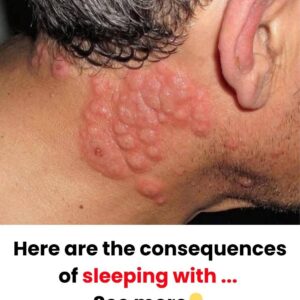A Silent Stroke Can Strike When You Least Expect It — But These Small Habits Could Save Your Life
In the realm of health and wellness, strokes often evoke images of sudden, debilitating events that change lives in an instant. While most understand the dangers of a full-blown stroke, a less recognized yet equally perilous threat lurks quietly within our bodies: the silent stroke. This condition, often going unnoticed until significant damage has occurred, exemplifies the importance of proactive health habits and early detection in preventing catastrophic outcomes.
**Understanding the Silent Stroke**
A silent stroke, also known as a silent cerebral infarct, occurs when blood flow to a part of the brain is temporarily or permanently reduced, causing small areas of brain tissue to die. Unlike typical strokes, which often manifest with dramatic symptoms such as sudden weakness, paralysis, speech difficulties, or loss of vision, silent strokes usually produce no obvious outward signs. Many individuals remain unaware they have experienced one until they undergo imaging for unrelated reasons or develop more serious neurological issues later in life.
Despite their subtlety, silent strokes are far from benign. Medical research indicates that they are common, particularly among older adults, and are associated with an increased risk of future strokes, cognitive decline, and dementia. The Centers for Disease Control and Prevention (CDC) estimates that about 25% of people aged 70 and above have silent strokes, emphasizing the importance of awareness and prevention.
**Why Silent Strokes Matter**
The dangers of missing silent strokes stem from their cumulative impact. While each silent event may involve only minor damage, repeated occurrences can significantly impair brain function over time. This progression can lead to difficulties with memory, concentration, movement, and other cognitive functions, sometimes culminating in irreversible disability.
Research also links silent strokes to an increased risk of heart disease, depression, and other neurological conditions. Recognizing the risk factors and adopting preventive measures can dramatically reduce the likelihood of these insidious strokes occurring.
**Risk Factors for Silent Stroke**
Several factors contribute to the risk of silent strokes, many of which are modifiable through lifestyle adjustments and medical management:
– **Hypertension (High Blood Pressure):** Elevated blood pressure remains the leading risk factor. It damages blood vessel walls and accelerates atherosclerosis, increasing the likelihood of vascular blockages.
– **Atrial Fibrillation:** Irregular heart rhythms can cause blood clots that travel to the brain, resulting in strokes.
– **High Cholesterol Levels:** Excess cholesterol contributes to plaque buildup within arteries, reducing blood flow.
– **Smoking:** The harmful chemicals in tobacco damage blood vessels and promote clot formation.
– **Diabetes:** Uncontrolled blood sugar levels can damage blood vessels and increase stroke risk.
– **Obesity and Sedentary Lifestyle:** Lack of physical activity and excess weight are linked to hypertension and other metabolic issues.
– **Age and Family History:** Advancing age and genetic predispositions also heighten vulnerability.
**Preventive Habits and Interventions**
While the silent nature of these strokes makes prevention challenging, adopting healthy lifestyle habits and medical interventions can significantly reduce risk. Here are essential strategies supported by current medical research:
1. **Regular Medical Screenings**
Routine check-ups are vital for early detection of risk factors such as high blood pressure, high cholesterol, and atrial fibrillation. Blood tests, blood pressure measurements, and, if recommended, brain imaging can identify silent strokes or predisposing conditions before symptoms appear.
2. **Blood Pressure Management**
Maintaining optimal blood pressure — generally below 130/80 mm Hg — reduces stress on blood vessels and minimizes the chance of both apparent and silent strokes. Lifestyle changes such as reducing salt intake, limiting alcohol, and managing stress contribute to better blood pressure control, complemented by prescribed medication if necessary.
3. **Managing Heart Conditions**
Effective management of atrial fibrillation and other cardiac issues through medication or procedures can prevent blood clots, decreasing stroke risk. Regular heart rhythm monitoring is advisable, especially for those with known arrhythmias.
4. **Healthy Diet**
A diet rich in fruits, vegetables, whole grains, lean proteins, and healthy fats supports vascular health. Reducing intake of saturated fats, trans fats, sodium, and processed foods further helps prevent plaque buildup and hypertension.
5. **Physical Activity**
Engaging in at least 150 minutes of moderate aerobic exercise weekly improves cardiovascular fitness, aids weight management, and stabilizes blood pressure. Activities such as walking, cycling, swimming, or yoga are excellent options for diverse fitness levels.
6. **Smoking Cessation**
Quitting smoking reduces damage to blood vessels and lowers the risk of clot formation. Support programs, nicotine replacement therapies, and counseling can facilitate quitting efforts.
7. **Weight Management**
Achieving and maintaining a healthy weight through diet and exercise reduces strain on the cardiovascular system and enhances overall health.
8. **Blood Sugar Control**
For individuals with diabetes, tight regulation of blood glucose levels through medication, diet, and lifestyle is crucial in preventing vascular damage.
9. **Limit Alcohol Consumption**
Excessive alcohol intake can raise blood pressure and contribute to other risk factors. Consuming alcohol in moderation or abstaining altogether is recommended.
10. **Mindful Medication Adherence**
For those prescribed medications for blood pressure, cholesterol, or heart rhythm management, consistent adherence is critical in reducing stroke risk.
**Emerging Technologies and Screening Tools**
Advancements in medical technology are improving early detection of silent strokes. Magnetic resonance imaging (MRI), especially diffusion-weighted imaging, can identify silent infarcts even when no symptoms have manifested. These scans are increasingly being used in research settings and for high-risk populations to catch issues early.
Moreover, wearable devices capable of monitoring heart rhythms and blood pressure are becoming more sophisticated, providing individuals with real-time health data and alerts that enable timely intervention.
**Awareness and Education: A Crucial Component**
Educating the public about silent strokes is essential in fostering proactive health behaviors. Because silent strokes often go unnoticed, individuals may dismiss subtle cognitive or physical changes as normal aging, ignoring underlying vascular issues. Healthcare providers play a pivotal role in conveying the significance of regular health assessments and lifestyle modifications.
Community programs, workplace wellness initiatives, and public health campaigns that emphasize stroke prevention and brain health can contribute to reducing the prevalence of silent strokes and their long-term consequences.
**Conclusion**
While silent strokes may lack the dramatic symptoms of their more overt counterparts, their impact on health is profound. Their insidious nature underscores the necessity of vigilance, regular health monitoring, and lifestyle choices aimed at vascular health. By adopting small but consistent habits like maintaining blood pressure, quitting smoking, engaging in physical activity, and managing chronic conditions, individuals can substantially reduce their risk and safeguard their cognitive and physical well-being.
Preventing silent strokes is not solely a matter of individual effort but a collective responsibility that involves healthcare providers, policymakers, workplaces, and communities. Recognizing the importance of early detection and prevention strategies is a critical step in combating this hidden threat, ultimately saving lives and preserving quality of life for countless individuals worldwide.
STAY TUNED !





